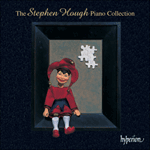
Welcome to Hyperion Records, an independent British classical label devoted to presenting high-quality recordings of music of all styles and from all periods from the twelfth century to the twenty-first.
Hyperion offers both CDs, and downloads in a number of formats. The site is also available in several languages.
Please use the dropdown buttons to set your preferred options, or use the checkbox to accept the defaults.

The first movement (Allegro) surges dramatically, pauses to reflect, rushes onwards with sparkling passagework, lingers introspectively before roaring on again – a stylistic mélange of writing that more closely resembles a fantasy than a formally structured sonata first movement (there is no exposition repeat, for example). Clementi was famous for his rapid passages in thirds (Mozart addressed his own inferiority in this respect by never writing such passages), a skill which he clearly passed on to his pupil, and Hummel’s episodes of con brio semiquaver runs in fourths and thirds must have challenged many others besides Schumann (Hummel’s B minor concerto written in the same year as this sonata, and the A minor concerto of 1821 are no less intimidating).
The slow movement (Largo con molt’espressione) opens not with a gentle sigh but an angry outburst (fortissimo), the first of a series of unexpected explosions that punctuate it. Hummel’s novel pianistic decoration during its course offers a fascinating anticipation of Chopin’s, even if its thematic material is less memorable. Jolting us abruptly from this meandering reverie comes the striking opening subject of the finale (Vivace), an impulsive folk-like dance. This, at last, is Hummel with the gloves off, the athletic writing on occasion using the entire compass of the keyboard in a single measure, making all kinds of cruel demands on the player, not least in stamina. Hummel provides two brief intervals of quiet relief (one a fugal passage in the major tonic) in an otherwise relentless drive to the thrilling conclusion.
from notes by Jeremy Nicholas © 2003
Le premier mouvement (Allegro) s’élance dramatiquement, s’arrête pour réfléchir, reprend de plus belle dans des traits scintillants, s’attarde introspectivement avant de s’envoler de nouveau – un mélange stylistique qui ressemble plus étroitement à une fantaisie qu’à un premier mouvement de sonate correctement structuré (il n’y a aucune reprise de l’exposition, par exemple). Clementi était célèbre pour ses passages rapides en tierces (Mozart traita sa propre infériorité en ce domaine en évitant d’écrire de tels passages), un talent qu’il transmit visiblement à son élève. Les épisodes de Hummel en traits con brio de doubles croches écrites en quartes ou en tierces ont dû poser des difficultés à bien d’autres pianistes que Schumann (le Concerto en si mineur de Hummel conçu la même année que cette sonate et le Concerto en la mineur de 1821 ne sont pas moins intimidants).
Le mouvement lent (Largo con molt’espressione) ne s’ouvre pas par un doux soupir mais par un éclat de colère (fortissimo), le premier d’une série d’explosions inattendues qui le ponctuent. Il fait aussi preuve tout du long d’une nouveauté dans sa décoration pianistique qui laisse présager celle de Chopin, même si le matériau thématique est moins mémorable. On est brusquement tiré d’une déambulation rêveuse par le premier thème saisissant du finale (Vivace), une danse impulsive d’allure folklorique. Voici enfin Hummel, sans gants blancs, qui déploie parfois une écriture athlétique sur toute l’étendue du clavier en un seul élan, qui impose de cruelles exigences à l’exécutant, ne serait-ce que par le niveau d’énergie requis. Il procure au pianiste deux courts instants d’accalmie (notamment un passage fugué à la tonique majeure) dans cette trajectoire implacable vers une conclusion palpitante.
extrait des notes rédigées par Jeremy Nicholas © 2003
Français: Isabelle Battioni
Der erste Satz (Allegro) schwillt dramatisch an, hält kurz inne und fährt dann mit sprudelnden Figuren fort, um nochmals nachdenklich zu verweilen und dann wieder weiter zu eilen: es ist dies ein stilistisches Mélange, das eher einer Fantasie denn dem ersten Satz einer formal strukturierten Sonate entspricht (so wird zum Beispiel die Exposition nicht wiederholt). Clementi war für seine rasanten Terzpassagen berühmt und diese Fertigkeit muss er seinem Schüler vermittelt haben (Mozart ging seine diesbezügliche Inferiorität insofern an, indem er nie solche Passagen komponierte). Hummels als con brio markierte Sechzehntelläufe in Quarten und Terzen müssen neben Schumann noch viele andere herausgefordert haben (Hummels h-Moll Konzert entstand im gleichen Jahr wie diese Sonate und das a-Moll Konzert von 1821 ist nicht minder verunsichernd).
Der langsame Satz (Largo con molt’espressione) beginnt nicht mit einem sanften Seufzer, sondern mit einem zornigen Ausbruch (fortissimo), der etwas später durch eine ganze Reihe von unerwarteten Explosionen noch stärker akzentuiert wird. Mit seinen neuartigen pianistischen Verzierungen antizipiert Hummel die Tonsprache Chopins auf faszinierende Weise, selbst wenn das thematische Material weniger eindrucksvoll ist. Nach einer beschaulichen Reverie beginnt recht abrupt das ungewöhnliche erste Thema des Finale (Vivace), ein impulsiver, rustikaler Tanz. Hier zeigt sich Hummel von seiner schonungslosen Seite: er komponiert geradezu athletisch, setzt zuweilen die gesamte Tastatur innerhalb eines Taktes ein und fordert den Ausführenden – und dessen Durchhaltevermögen – auf fast grausame Weise. Hummel gewährt dem Spieler zwei kurze Verschnaufpausen (eine davon ist eine fugale Passage in der Durtonika) und führt den sonst unermüdlichen Satz zu einem überwältigenden Ende.
aus dem Begleittext von Jeremy Nicholas © 2003
Deutsch: Viola Scheffel
 The Stephen Hough Piano Collection The Stephen Hough Piano Collection'This is a fine introduction to the piano playing of one of the great talents of the present age' (MusicWeb International)» More |

